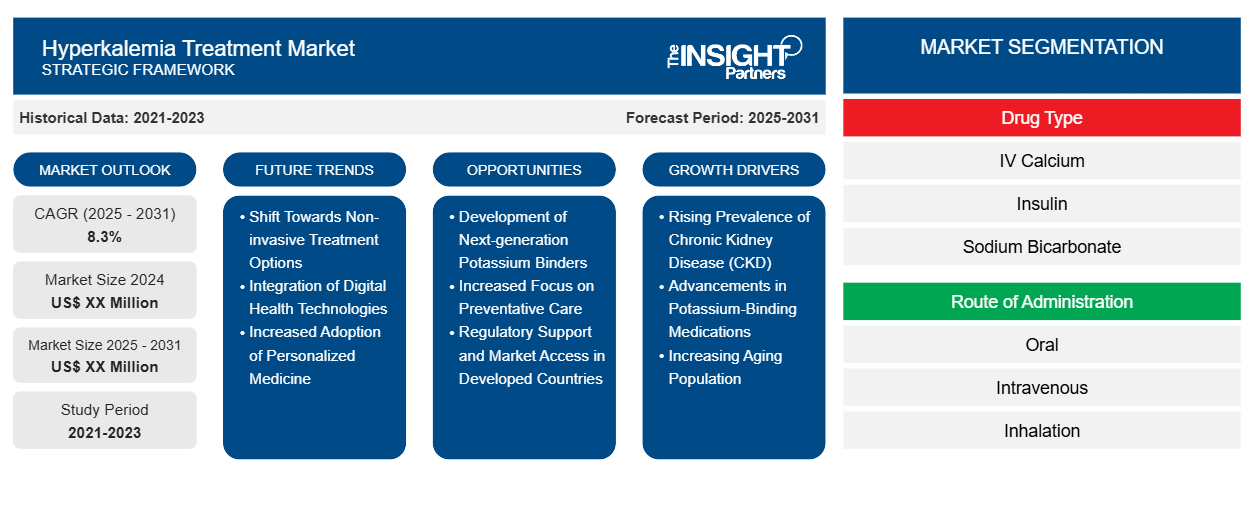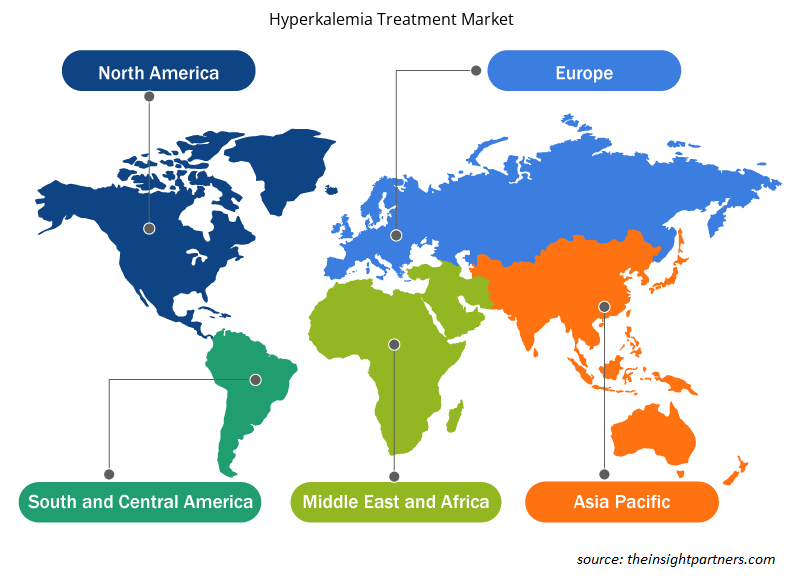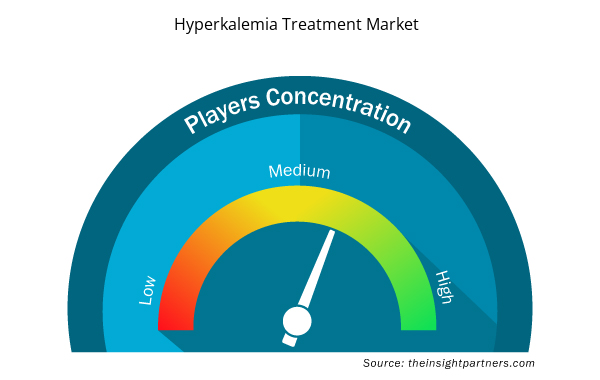The Hyperkalemia Treatment Market is expected to register a CAGR of 8.3% from 2025 to 2031, with a market size expanding from US$ XX Million in 2024 to US$ XX Million by 2031.
The research report on the Hyperkalemia Treatment Market is segmented by type into diuretics, resins, and intravenous calcium. Applications analyzed include chronic kidney disease treatment, cardiovascular disease management, and emergency hyperkalemia care. End-users include hospitals, dialysis centers, pharmaceutical companies, and healthcare providers. The regional analysis covers key markets such as North America, Europe, Asia Pacific, the Middle East and Africa, and South America. The market evaluation is presented in US$ for all segmental analyses. This report evaluates the growing prevalence of hyperkalemia, the increasing need for effective treatment options, and emerging therapeutic innovations in managing potassium imbalance.
Purpose of the Report
The report Hyperkalemia Treatment Market by The Insight Partners aims to describe the present landscape and future growth, top driving factors, challenges, and opportunities. This will provide insights to various business stakeholders, such as:
- Technology Providers/Manufacturers: To understand the evolving market dynamics and know the potential growth opportunities, enabling them to make informed strategic decisions.
- Investors: To conduct a comprehensive trend analysis regarding the market growth rate, market financial projections, and opportunities that exist across the value chain.
- Regulatory bodies: To regulate policies and police activities in the market with the aim of minimizing abuse, preserving investor trust and confidence, and upholding the integrity and stability of the market.
Hyperkalemia Treatment Market Segmentation
Drug Type
- IV Calcium
- Insulin
- Sodium Bicarbonate
- Beta2 Agonist
- Diuretics
- Sodium Polystyrene Sulfonate
Route of Administration
- Oral
- Intravenous
- Inhalation
- Rectal
Distribution Channel
- Hospital Pharmacy
- Retail Pharmacy
- Online Pharmacy
Customize This Report To Suit Your Requirement
You will get customization on any report - free of charge - including parts of this report, or country-level analysis, Excel Data pack, as well as avail great offers and discounts for start-ups & universities
Hyperkalemia Treatment Market: Strategic Insights

- Get Top Key Market Trends of this report.This FREE sample will include data analysis, ranging from market trends to estimates and forecasts.
Hyperkalemia Treatment Market Growth Drivers
- Rising Prevalence of Chronic Kidney Disease (CKD): One of the key growth drivers in the hyperkalemia treatment market is the rising prevalence of chronic kidney disease (CKD), which is closely associated with hyperkalemia. CKD patients often experience impaired kidney function, which reduces the ability to excrete potassium, leading to high potassium levels in the blood. This condition, known as hyperkalemia, can cause severe cardiac complications if left untreated. The global prevalence of CKD is on the rise, primarily due to factors like aging populations, diabetes, hypertension, and lifestyle-related issues. As CKD cases increase, the demand for effective hyperkalemia treatments grows in parallel. Market forecasts predict that the global market size for hyperkalemia treatments will continue to expand as healthcare systems focus on early detection and management of CKD. This is expected to increase the market share for treatments targeting hyperkalemia, such as potassium binders, diuretics, and dialysis. As a result, healthcare professionals are increasingly prioritizing potassium management in CKD patients, which will fuel the growth of the hyperkalemia treatment market. Furthermore, as CKD progresses and patients develop hyperkalemia, specialized treatments are required to prevent life-threatening complications, further driving market demand.
- Advancements in Potassium-Binding Medications: The development of new potassium-binding medications is significantly driving the growth of the hyperkalemia treatment market. Potassium binders, which are used to lower blood potassium levels, have seen significant advancements in recent years. Medications such as patiromer and sodium zirconium cyclosilicate (SZC) are providing more effective and safer options for patients suffering from hyperkalemia. These medications offer improved potassium control with fewer side effects compared to older treatments, such as potassium-wasting diuretics or sodium polystyrene sulfonate (SPS), which can have adverse effects on the gastrointestinal system. The introduction of these new and improved drugs has the potential to expand the market size for hyperkalemia treatments and increase their market share. According to market research, the efficacy and safety of these potassium binders have led to a significant shift in clinical treatment guidelines, encouraging their adoption in both hospital and outpatient settings. This shift is driving greater demand for modern potassium binders, which are expected to continue to fuel the market’s growth in the coming years. As more innovative and highly effective treatments become available, the treatment landscape for hyperkalemia will evolve, offering new opportunities for both established and emerging players in the industry.
- Increasing Aging Population: The aging global population is a significant driver for the hyperkalemia treatment market. As individuals age, their kidney function naturally declines, making them more susceptible to conditions such as hyperkalemia. The elderly population is more likely to develop comorbidities, such as hypertension, diabetes, and heart disease, all of which increase the risk of hyperkalemia. Older adults often require more frequent monitoring of potassium levels, as they are at greater risk of potassium imbalances due to reduced renal function. Market forecasts indicate that as the global population continues to age, the demand for treatments for hyperkalemia will increase accordingly. The market size for hyperkalemia treatments will likely see substantial growth due to the increasing incidence of hyperkalemia in the elderly. As healthcare systems focus on managing chronic conditions in aging populations, the market share for hyperkalemia treatments will expand, especially with the advent of specialized therapies designed to address the unique needs of older patients. This demographic shift is expected to drive long-term growth in the hyperkalemia treatment market, with significant opportunities for innovative treatments targeting the elderly population.
Hyperkalemia Treatment Market Future Trends
- Shift Towards Non-invasive Treatment Options: A major trend in the hyperkalemia treatment market is the growing preference for non-invasive treatment options. Traditional treatments for hyperkalemia, such as intravenous calcium, sodium bicarbonate, or hemodialysis, require medical intervention in a hospital setting. However, there is a growing trend toward more convenient, oral, and at-home therapies. Medications such as patiromer and sodium zirconium cyclosilicate (SZC) are offering patients the ability to manage their hyperkalemia from the comfort of their homes, reducing hospital visits and associated healthcare costs. Market forecasts predict that non-invasive treatments will continue to gain market share as they provide a more patient-friendly approach to managing potassium imbalances. This trend is expected to increase the market size of hyperkalemia treatments by making treatment options more accessible and less dependent on frequent hospitalizations. As a result, more patients will be able to benefit from these oral medications, contributing to the overall growth of the market. The shift toward oral and at-home treatment solutions aligns with the broader healthcare trend of patient-centered care and convenience, making this an important development within the hyperkalemia treatment market.
- Integration of Digital Health Technologies: The integration of digital health technologies, such as mobile health apps and wearable devices, is another significant trend in the hyperkalemia treatment market. These technologies enable patients to monitor their potassium levels in real-time and share data with healthcare providers, improving treatment outcomes and preventing complications. Digital health solutions help ensure better compliance with prescribed medications, providing both patients and doctors with real-time insights into the patient's condition. Market research shows that the use of digital health technologies is becoming more widespread in the management of chronic diseases, including hyperkalemia. Market forecasts suggest that this trend will continue to grow, with digital platforms facilitating the management of potassium levels and enhancing treatment plans. The market share for hyperkalemia treatments will likely increase as digital tools allow for more precise monitoring and individualized care. These innovations contribute to better disease management, improving patient outcomes and fostering growth in the hyperkalemia treatment market.
- Increased Adoption of Personalized Medicine: Personalized medicine is gaining traction in the management of hyperkalemia, as healthcare providers move towards treatment plans that are tailored to an individual’s unique genetic makeup and health profile. Personalized treatment for hyperkalemia allows for more precise management of potassium levels based on a patient's specific condition, comorbidities, and lifestyle factors. With advances in pharmacogenomics, treatments can be customized to ensure the most effective potassium control with minimal side effects. Market forecasts predict that personalized medicine will play a key role in the future of hyperkalemia treatment, expanding market size and increasing market share for therapies that offer personalized solutions. The trend toward more individualized care, which is becoming increasingly common in various therapeutic areas, is expected to drive growth in the hyperkalemia treatment market. As more treatment options become available that cater to specific patient needs, this trend will help broaden the scope and application of hyperkalemia therapies.
Hyperkalemia Treatment Market Opportunities
- Development of Next-generation Potassium Binders: One of the most promising growth opportunities in the hyperkalemia treatment market is the development of next-generation potassium binders. These novel medications are designed to be more effective and have fewer side effects compared to current treatments. For example, the development of novel potassium binders that provide sustained-release formulations or address more complex causes of hyperkalemia presents a significant opportunity for market expansion. As market share increases for these advanced therapies, the market size is expected to grow exponentially. With better efficacy, safety profiles, and patient adherence, these next-generation drugs could revolutionize the treatment of hyperkalemia, making it easier to manage and ultimately driving growth in the sector.
- Increased Focus on Preventative Care: An increasing focus on preventative healthcare, particularly in the management of chronic diseases, offers an opportunity for the hyperkalemia treatment market. With an emphasis on early detection and proactive treatment, healthcare providers are focusing on identifying and addressing potassium imbalances before they lead to severe complications. Market forecasts suggest that this preventative approach will lead to increased demand for hyperkalemia treatments as part of broader healthcare management programs for patients with chronic kidney disease, diabetes, or heart failure. Market share is expected to increase as more healthcare providers adopt early intervention strategies to treat hyperkalemia. This shift toward prevention offers new opportunities for pharmaceutical companies to introduce products aimed at early-stage hyperkalemia management, driving both growth and market expansion.
- Regulatory Support and Market Access in Developed Countries: Developed countries such as the United States, Canada, and those in the European Union offer substantial growth opportunities for hyperkalemia treatments due to favorable regulatory environments. With robust healthcare systems and supportive regulatory frameworks for new drug approvals, these regions provide an ideal landscape for launching new therapies. Market research shows that the approval of new potassium binders and treatments in these countries is expected to drive market growth. Additionally, the increasing availability of these treatments through insurance coverage and healthcare programs will contribute to the market size and market share. Companies that successfully navigate regulatory pathways in these regions are well-positioned to capitalize on the growing demand for effective hyperkalemia treatments.
Hyperkalemia Treatment Market Regional Insights
The regional trends and factors influencing the Hyperkalemia Treatment Market throughout the forecast period have been thoroughly explained by the analysts at Insight Partners. This section also discusses Hyperkalemia Treatment Market segments and geography across North America, Europe, Asia Pacific, Middle East and Africa, and South and Central America.

- Get the Regional Specific Data for Hyperkalemia Treatment Market
Hyperkalemia Treatment Market Report Scope
| Report Attribute | Details |
|---|---|
| Market size in 2024 | US$ XX Million |
| Market Size by 2031 | US$ XX Million |
| Global CAGR (2025 - 2031) | 8.3% |
| Historical Data | 2021-2023 |
| Forecast period | 2025-2031 |
| Segments Covered |
By Drug Type
|
| Regions and Countries Covered | North America
|
| Market leaders and key company profiles |
Hyperkalemia Treatment Market Players Density: Understanding Its Impact on Business Dynamics
The Hyperkalemia Treatment Market market is growing rapidly, driven by increasing end-user demand due to factors such as evolving consumer preferences, technological advancements, and greater awareness of the product's benefits. As demand rises, businesses are expanding their offerings, innovating to meet consumer needs, and capitalizing on emerging trends, which further fuels market growth.
Market players density refers to the distribution of firms or companies operating within a particular market or industry. It indicates how many competitors (market players) are present in a given market space relative to its size or total market value.
Major Companies operating in the Hyperkalemia Treatment Market are:
- AstraZeneca
- Klarvoyant Biogenics Pvt. Ltd
- Concordia Pharmaceuticals Inc
- Steadfast MediShield Pvt. Ltd
- Perrigo Company plc
- AdvaCare Pharma
Disclaimer: The companies listed above are not ranked in any particular order.

- Get the Hyperkalemia Treatment Market top key players overview
Key Selling Points
- Comprehensive Coverage: The report comprehensively covers the analysis of products, services, types, and end users of the Hyperkalemia Treatment Market, providing a holistic landscape.
- Expert Analysis: The report is compiled based on the in-depth understanding of industry experts and analysts.
- Up-to-date Information: The report assures business relevance due to its coverage of recent information and data trends.
- Customization Options: This report can be customized to cater to specific client requirements and suit the business strategies aptly.
The research report on the Hyperkalemia Treatment Market can, therefore, help spearhead the trail of decoding and understanding the industry scenario and growth prospects. Although there can be a few valid concerns, the overall benefits of this report tend to outweigh the disadvantages.
- Historical Analysis (2 Years), Base Year, Forecast (7 Years) with CAGR
- PEST and SWOT Analysis
- Market Size Value / Volume - Global, Regional, Country
- Industry and Competitive Landscape
- Excel Dataset


- Parking Management Market
- Environmental Consulting Service Market
- Aircraft Wire and Cable Market
- Retinal Imaging Devices Market
- Military Rubber Tracks Market
- Digital Language Learning Market
- Non-Emergency Medical Transportation Market
- Lyophilization Services for Biopharmaceuticals Market
- Intradermal Injection Market
- Skin Tightening Market

Report Coverage
Revenue forecast, Company Analysis, Industry landscape, Growth factors, and Trends

Segment Covered
This text is related
to segments covered.

Regional Scope
North America, Europe, Asia Pacific, Middle East & Africa, South & Central America

Country Scope
This text is related
to country scope.
Frequently Asked Questions
The Hyperkalemia Treatment Market is expected to register a CAGR of 8.3% from 2025-2031.
The major driving factors supporting the Hyperkalemia Treatment Market growth are- Rising Prevalence of Chronic Kidney Disease (CKD), Advancements in Potassium-Binding Medications
Key Future Trends in the Hyperkalemia Treatment Market are- Shift Towards Non-invasive Treatment Options, Integration of Digital Health Technologies, and Increased Adoption of Personalized Medicine.
Key companies in Hyperkalemia Treatment Market are - AstraZeneca, Klarvoyant Biogenics Pvt. Ltd, Concordia Pharmaceuticals Inc, Steadfast MediShield Pvt. Ltd, Perrigo Company plc, AdvaCare Pharma, Eli Lilly and Company, Carolina Medical Products, Relypsa, Inc.
The report can be delivered in PDF/PPT format; we can also share excel dataset based on the request.
Some of the customization options available based on request are additional 3–5 company profiles and country-specific analysis of 3–5 countries of your choice. Customizations are to be requested/discussed before making final order confirmation, as our team would review the same and check the feasibility.
Trends and growth analysis reports related to Life Sciences : READ MORE..
1. AstraZeneca
2. Klarvoyant Biogenics Pvt. Ltd
3. Concordia Pharmaceuticals Inc
4. Steadfast MediShield Pvt. Ltd
5. Perrigo Company plc
6. AdvaCare Pharma
7. Eli Lilly and Company
8. Carolina Medical Products
9. Relypsa, Inc.
10. RSM Kilitch Pharma Pvt. Ltd

 Get Free Sample For
Get Free Sample For